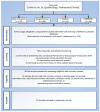Machine Learning, Deep Learning, and Mathematical Models to Analyze Forecasting and Epidemiology of COVID-19: A Systematic Literature Review
- PMID: 35564493
- PMCID: PMC9099605
- DOI: 10.3390/ijerph19095099
Machine Learning, Deep Learning, and Mathematical Models to Analyze Forecasting and Epidemiology of COVID-19: A Systematic Literature Review
Abstract
COVID-19 is a disease caused by SARS-CoV-2 and has been declared a worldwide pandemic by the World Health Organization due to its rapid spread. Since the first case was identified in Wuhan, China, the battle against this deadly disease started and has disrupted almost every field of life. Medical staff and laboratories are leading from the front, but researchers from various fields and governmental agencies have also proposed healthy ideas to protect each other. In this article, a Systematic Literature Review (SLR) is presented to highlight the latest developments in analyzing the COVID-19 data using machine learning and deep learning algorithms. The number of studies related to Machine Learning (ML), Deep Learning (DL), and mathematical models discussed in this research has shown a significant impact on forecasting and the spread of COVID-19. The results and discussion presented in this study are based on the PRISMA (Preferred Reporting Items for Systematic Reviews and Meta-Analyses) guidelines. Out of 218 articles selected at the first stage, 57 met the criteria and were included in the review process. The findings are therefore associated with those 57 studies, which recorded that CNN (DL) and SVM (ML) are the most used algorithms for forecasting, classification, and automatic detection. The importance of the compartmental models discussed is that the models are useful for measuring the epidemiological features of COVID-19. Current findings suggest that it will take around 1.7 to 140 days for the epidemic to double in size based on the selected studies. The 12 estimates for the basic reproduction range from 0 to 7.1. The main purpose of this research is to illustrate the use of ML, DL, and mathematical models that can be helpful for the researchers to generate valuable solutions for higher authorities and the healthcare industry to reduce the impact of this epidemic.
Keywords: basic reproduction rate; deep learning; epidemiology of COVID-19; machine learning.
Conflict of interest statement
The authors declare no conflict of interest. In addition, the funders had no role in the design of the study; in the collection, analyses, or interpretation of data; in the writing of the manuscript, or in the decision to publish the results.
Figures










Similar articles
-
Signs and symptoms to determine if a patient presenting in primary care or hospital outpatient settings has COVID-19.Cochrane Database Syst Rev. 2022 May 20;5(5):CD013665. doi: 10.1002/14651858.CD013665.pub3. Cochrane Database Syst Rev. 2022. PMID: 35593186 Free PMC article.
-
Rapid, point-of-care antigen tests for diagnosis of SARS-CoV-2 infection.Cochrane Database Syst Rev. 2022 Jul 22;7(7):CD013705. doi: 10.1002/14651858.CD013705.pub3. Cochrane Database Syst Rev. 2022. PMID: 35866452 Free PMC article.
-
Antibody tests for identification of current and past infection with SARS-CoV-2.Cochrane Database Syst Rev. 2022 Nov 17;11(11):CD013652. doi: 10.1002/14651858.CD013652.pub2. Cochrane Database Syst Rev. 2022. PMID: 36394900 Free PMC article.
-
Cost-effectiveness of using prognostic information to select women with breast cancer for adjuvant systemic therapy.Health Technol Assess. 2006 Sep;10(34):iii-iv, ix-xi, 1-204. doi: 10.3310/hta10340. Health Technol Assess. 2006. PMID: 16959170
-
Weed Detection Using Deep Learning: A Systematic Literature Review.Sensors (Basel). 2023 Mar 31;23(7):3670. doi: 10.3390/s23073670. Sensors (Basel). 2023. PMID: 37050730 Free PMC article.
Cited by
-
DeepDynaForecast: Phylogenetic-informed graph deep learning for epidemic transmission dynamic prediction.PLoS Comput Biol. 2024 Apr 10;20(4):e1011351. doi: 10.1371/journal.pcbi.1011351. eCollection 2024 Apr. PLoS Comput Biol. 2024. PMID: 38598563 Free PMC article.
-
Applying machine learning techniques to predict the risk of lung metastases from rectal cancer: a real-world retrospective study.Front Oncol. 2023 May 24;13:1183072. doi: 10.3389/fonc.2023.1183072. eCollection 2023. Front Oncol. 2023. PMID: 37293595 Free PMC article.
-
Mathematical Contact Tracing Models for the COVID-19 Pandemic: A Systematic Review of the Literature.Healthcare (Basel). 2025 Apr 18;13(8):935. doi: 10.3390/healthcare13080935. Healthcare (Basel). 2025. PMID: 40281884 Free PMC article. Review.
-
Covid-19, Diagnostic History and Mortality from Medicare 1999-2021, In an All-Cause Mortality Approach.Arch Intern Med Res. 2023;6(4):74-85. doi: 10.26502/aimr.0151. Epub 2023 Oct 30. Arch Intern Med Res. 2023. PMID: 39726831 Free PMC article.
-
Real-time infectious disease endurance indicator system for scientific decisions using machine learning and rapid data processing.PeerJ Comput Sci. 2024 Jul 30;10:e2062. doi: 10.7717/peerj-cs.2062. eCollection 2024. PeerJ Comput Sci. 2024. PMID: 39145255 Free PMC article.
References
-
- WHO WHO Director-General’s Opening Remarks at the Media Briefing on COVID-19. 11 March 2020. [(accessed on 15 August 2020)]. Available online: https://www.who.int/dg/speeches/detail/who-director-general-s-opening-re....
-
- Wang D., Yin Y., Hu C., Liu X., Zhang X., Zhou S., Jian M., Xu H., Prowle J., Hu B. Clinical course and outcome of 107 patients infected with the novel coronavirus, SARS-CoV-2, discharged from two hospitals in Wuhan, China. Crit. Care. 2020;24:188. doi: 10.1186/s13054-020-02895-6. - DOI - PMC - PubMed
-
- Yang X., Yu Y., Xu J., Shu H., Liu H., Wu Y., Zhang L., Yu Z., Fang M., Yu T. Clinical course and outcomes of critically ill patients with SARS-CoV-2 pneumonia in Wuhan, China: A single-centered, retrospective, observational study. Lancet Respir. Med. 2020;8:475–481. doi: 10.1016/S2213-2600(20)30079-5. - DOI - PMC - PubMed
-
- Xu J., Yang X., Yang L., Zou X., Wang Y., Wu Y., Zhou T., Yuan Y., Qi H., Fu S. Clinical course and predictors of 60-day mortality in 239 critically ill patients with COVID-19: A multicenter retrospective study from Wuhan, China. Crit. Care. 2020;24:394. doi: 10.1186/s13054-020-03098-9. - DOI - PMC - PubMed
Publication types
MeSH terms
LinkOut - more resources
Full Text Sources
Medical
Miscellaneous

